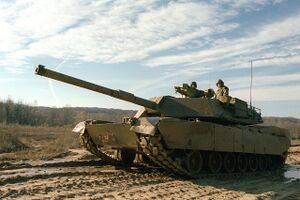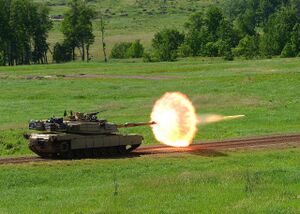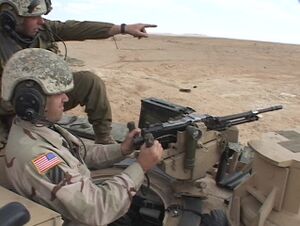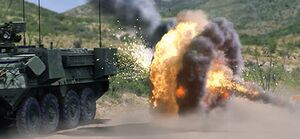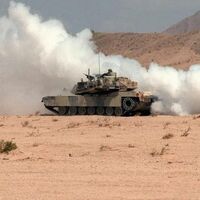Valkyrie 2
| Valkyrie 2 | |
|---|---|
 A Valkyrie 2A3 rolls down a dirt road in Afghanistan. The remote weapon station is clearly visible. | |
| Type | Main Battle Tank |
| Place of origin | Atlantia |
| Service history | |
| In service | 2002-Present |
| Used by | Atlantia |
| Production history | |
| Designer | EVG |
| Designed | 1975-1997 |
| Manufacturer | EVG |
| Produced | 1997-Present |
| No. built | 1752 |
| Variants | 5 |
| Specifications (Main Battle Tank) | |
| Weight | 62 tons |
| Length | Hull length: 7.93 m Gun forward: 9.77 m |
| Width | 3.66 m |
| Height | 2.44 m |
| Crew | 4 (Commander, driver, gunner, loader) |
| Armor | Rhineland-class composite armour with depleted uranium reinforcement |
Main armament | 2A0, 2A1: 120 mm L44 Rhinemetal smoothbore gun (40 rounds) 2A2,2A3: 120 mm L55 Rhinemetal smoothbore gun (42 rounds) |
Secondary armament | 1 × .50-caliber (12.7 mm) MG-5 heavy machine gun with 1000 rounds 2 × 7.62 mm (.308 in) M240F machine guns with 10,400 rounds (1 pintle-mounted, 1 coaxial) |
| Engine | MTU MB 873 Ka-501 liquid-cooled V12 twin-turbo diesel engine 1500 hp (1,103 kW) at 2,600 rpm |
| Suspension | Titanium-reinforced polycarbornate torsion bar suspension |
Operational range | 550km |
| Speed | 72 km/h on road 56 km/h offroad |
The Valkyrie 2 is a fourth generation main battle tank developed by Europäische Verteidigungsgruppe (EVG, English: European Defence Group) for the Atlantian Army. The Valkyrie is heavily armoured, armed and designed for rapid mobile manoeuvre warfare, sporting heavy composite armour reinforced with depleted uranium reinforcement, a 55 calibre 120 mm gun and a powerful 1500 horsepower twin-turbo diesel engine.
It was developed from 1997-2001 and entered service with the Atlantian Army in 2002, replacing the Valkyrie 1 in front-line service. Five variants of the Valkyrie 2 have been developed: the Valkyrie 2, 2A1, 2A2, 2A3 and 2E1 combat engineer vehicle.
History
Development
When the predecessor to the Valkyrie 2, the Valkyrie 1 was introduced into service in 1975, the Atlantian military knew they had to start the development on a new main battle tank to prepare for future threats. The Valkyrie 1 was developed in mind to counter the threat of mass assaults by Unfallion armoured forces. Hence the Valkyrie 1 incorporated some of the most advanced technology at the time, including composite armour and electro-optical rangefinders. Designers at EVG performed an extensive study of the Valkyrie 1 and equivalent main battle tanks of allies and opponents. By 1980, a preliminary design was reached and work shortly began on prototypes for evaluation by the Atlantian Army.
The prototypes were constructed by the end of 1982 and named the "Wolf". The Wolf featured composite armour like it's predecessor and also a radical turret design which included an auto loading 105 mm gun. This brought a lot of controversy as the Valkyrie 1 had been equipped with a hand-loaded 120 mm gun. Fears were generated that the 105 mm gun would not be able to defeat contemporary Unfallion designs. In addition, the Wolf had emphasised speed over protection, featuring a 1500 horsepower multifuel turbine, making, it the fastest MBT in the world at the time. During trials the Wolf reached over 75 km/h and could accelerate to 50 km/h in 10 seconds. However during gunnery tests, the 105 mm gun failed to penetrate a 500 mm thick plate at ranges above 1000 m. In addition, the Wolf's armour was unable to resist an armour piercing sabot from a 125 mm gun at ranges of 1000 m. Promptly, the Atlantian Army rejected the design, citing how the Wolf would be unable to effectively combat Unfallion tanks.
EVG then adapted the Wolf design into an improved version of the Valkyrie 1. It was decided to abandon the autoloading 105 mm gun and install a longer calibre 120 mm gun that was hand loaded. The hull of the Wolf was also modified: the engine design was changed to a conventional diesel turbine that increased reliability, lifespan, fuel efficiency and shorted the engine by a few dozen centimetres. This enabled the designers to mount heavier armour on the tank, which was now codenamed "Sledgehammer". The Sledgehammer received, in addition to composite armour, depleted uranium plating. In testing, the plating could withstand the guns of any contemporary MBT at point-blank range. Updated electronics equipment was also integrated with the tank, with the commander receiving a thermal viewing station and the gunner receiving a digital ballistics computer.
The first prototypes of the Sledgehammer were ready by 1989, however due to the decrease of Unfallion military buildup and a detente with the USCS, there was a massive cut in the budget for the Atlantian Army. Henceforth the Sledgehammer design was put on hold and it was regarded to be more cost-effective to upgrade the current Valkyrie 1 tanks in the Atlantian inventory. The existing Sledgehammer prototypes were put into storage and left relatively forgotten. However, in 1991, during the Gulf War, Atlantian Valkyrie 1s suffered several losses from Iraqi T-72s, indicating a need for a better main battle tank for the Atlantian Army. Thus the Sledgehammer prototypes were taken out of storage and trials began on them.
In the trials, the Sledgehammer design performed admirably and proved to be extremely resistant to cannon fire and was able to execute tanks up to 2.5 km away. In addition the tank was also quite fast; reaching 72 km/h on roads and 50 km/h offroads. Thus in 1996 the design passed the trials and the Atlantian army asked EVG to modify the design slightly to suit their needs better. Among these changes include an infantry telephone on the rear of the hull, next to the engine exhaust, a titanium thermal sleeve for the gun and reinforced shock absorbers for the torsion bar suspension system. By 1997 the Sledgehammer was accepted into Atlantian Army service as the Valkyrie 2.
Design
Armament
RM-120 smoothbore gun
The primary armament of the Valkyrie 2 is the 120 mm RM120 smoothbore gun, designed by Rhinemetal AG. On the Valkryie 2 and 2A1, the RM120 is used, which has a length of 44 calibres. However, on the Valkyrie 2A2 and 2A3, the RM120A1 is used, which is 11 calibres longer. The decision was made to extend the barrel length to guarantee lethality at extreme ranges exceeding 5 kilometers.
The RM-120 is able to fire a multitude of ammunition, with the primary anti-tank round being the Kanonen Munition 777 (KM-777). The KM-777 is an armour-piercing fin stabilised discarding sabot (APFSDS) round with a penetrator 850 mm in length. It features a higher amount of propellant than the previous rounds used by the Valkyrie 1 and is able to reach an estimated velocity if 2,221 m/s. The velocity of the round is so fast, the air is superheated around it, creating a stream of plasma that trails the round. Upon impact the sheer kinetic energy generated superheats the air around it and incinerates the interior of the tank if penetrated. The round is made purely of depleted uranium and thus provides extreme amounts of penetration upon impact, with an estimated penetration of 1000 mm against rolled homogeneous steel.
In addition, the RM-120 fires the KM-255 HEAT round, for use against less armoured targets and demolition purposes. It contains 12 kilograms of shaped charge explosive and is effective at destroying light armoured vehicles, infantry and buildings/constructions. The round features a smart fuse and is able to detonate the anti-armour copper jet or just the explosive for increased versatility. The estimated penetration capability of the plasma jet generated by the HEAT warhead is approximately 800 mm.
Furthermore, the RM-120 fires a dedicated anti-infantry canister shot, named the KM-627. The round is designed to airburst before impact and upon detonation, 1200 tungsten balls of 9 mm diameter are released, creating a shotgun effect that is deadly up to 700 m away. In addition the balls are coated with tungsten carbide, designed to increase spalling and yawing upon impact with flesh. The canister shot is also effective at disabling or damaging lightly armoured material such as sensors, radars, optics and light vehicles.
Secondary
The Valkyrie 2 features four machine guns:
- A 50.cal (12.7 mm) MG-5 heavy machine gun mounted in a pintle mount in front of the commander's hatch with 1000 rounds of ammunition. The Valkyrie 2A0 and A1 variants had an exposed pintle mount that left the commander vulnerable to retaliatory fire, so the A2 and A3 variants have added an remote weapons station that allows the commander to fire the machine gun from within the safe confines of the tank or transparent gunshields to shield the commander.
- A 7.62 mm M240F or another MG-5 machine gun mounted in front of the loader's hatch with a gunshield to protect the loader. The gun is mounted on a skate mount, allowing for easy traversal to engage threats from around the sides of the tank. It has 5200 rounds of ammunition.
- A 7.62 mm M240F machine gun as the tank's coaxial gun. It has 5200 rounds of ammunition and is operated by the gunner.
- An option MG-5 machine gun can be attached to the RM-120's gun barrel and electronically fired from inside the tank. The gunner also operates this gun.
Protection
Armour
The Valkyrie 2 is one of the best protected tanks in the world, sporting a composite armour matrix that lines the tank. The composite armour, named the Rhineland-class, while classified, is rumoured to consist of several layers of ceramic sandwiched between layers of depleted uranium and carbon nano-tubes. The purpose of the composite armour is to create uniform layers of armour that disrupt the penetrative energy of an anti-tank round. This makes the armour very resistant to kinetic penetrators and especially HEAT warheads. In addition the composite armour is encased in a shell of depleted uranium that provides further protection and also coated with tungsten carbide that provides extreme heat resistance against plasma rounds like the XM-182 KPS. Estimates on protection levels range from 900-1200 mm against KE penetrators and up to 1500 mm against HEAT warheads.
Active protection system
The Valkyrie 2 features the "Legion" active protection system (APS), which is a combination of softkill and hardkill active protect systems. The APS is designed to prevent the tank from receiving as much damage as possible. The softkill system is engaged first and consists of an array of electronic and jamming countermeasures, such as infrared dazzlers that confuse infrared seekers and electronic jamming systems that confuse laser guided and radar guided missile. The hardkill system is used when the softkill system fails in confusing the missile. The hardkill system consists of a close-in countermeasure system (CICS) that fires out pellets of tungsten balls at an incoming missile or projectile in an attempt to destroy or malform the projectile. The system is guided by a small radar sensor that guides both the softkill and hardkill systems and can detect when the tank is being locked on by a missile. Additional sensor systems include underbelly LADAR that scans the ground for anti-tank mines or IEDs, which was implemented on all Valkyrie 2 tanks after experience in Afghanistan demonstrated the vulnerability of tanks to infantry explosive devices.
Concealment
Camouflage
The Valkyrie 2 features a variety of concealment options. The Valkyrie 2 can be painted with a variety of camouflages to suit the combat environment it is in, but perhaps the most common camouflage fitted onto Valkyrie tanks is the desert paint scheme, due to recent Atlantian operations in the Middle East. In addition the Valkyrie 2 is painted commonly in a multi-coloured forest camouflage for operations in Europe. The paint applied to the Valkyrie 2 features materials that reduce the heat signature of the tank and radar signature, leading to some crews dubbing the paint as "ghost paint".
Smokescreens
Smoke generation capabilities of the Valkyrie 2 consist of two smoke launchers with 10 shots each mounted to the sides of the turret. In addition the tank has a smoke generator mounted in the engine compartment, where fuel is sprayed into a special exhaust tube that contains the hot exhaust fumes of the engine. This creates a thick smoke. The smoke generated by the smoke launchers are filled with small metallic particles and objects that confuse missile seekers.
Mobility
Tactical
The MTU MB 873 Ka-501 liquid-cooled V12 twin-turbo diesel engine serves as the engine of the Valkyrie 2 and provides 1500 shaft horsepower (1103 kW) at 2600 rpm. This gives the tank a power to weight ratio of 24.19 hp/t and propels the tank to a top speed of 72 km/h on roads and 50 km/h offroad, making it one of the fastest tanks in the world and giving it superior mobility to counterparts like the Kalaronian AMBT-443. The Ka-501 is primarily fuelled by diesel, giving it very good efficiency and allowing the tank to cover a maximum of 550 km. However the engine also has multi-fuel capabilities, but fuel efficiency will vary depending on the fuel. The engine is connected to the Renk HSWL 354 transmission, with four forward and two reverse gears. While the tank is governed to 72 km/h, it can achieve a maximum of 92 km/h if the governor is removed and is driven on good terrain. However significant damage to the suspension and propulsion systems along with the crew is likely to occur at those speeds. The Ka-501 has gained a reputation of being mechanically reliable and also features a five fan cooling system and copper radiator that reduces heat signatures up to 39% compared to other engine designs.
Furthermore, the Valkyrie 2 can climb obstacles up to 1.2 metres in height, ford rivers up to 3 meters in depth (provided all the hatches are closed and the engine exhausts are sealed or 5 meters with a snorkel. Also the tank can have a dozen soldiers mounted on it for transport, as long as the gunner traverses the turret at 50% normal speed.
Strategic
Due to the restrictive 62 ton weight of the Valkyrie 2, the only aerial transport in the Atlantian fleet that can transport it is the C-17 Globemaster and it can only be done one at a time. This results in a major logistics issue as it takes several sorties for a squadron of transports to transport a sizeable number of the tanks. This proved to be problematic during the 2003 Atlantian deployment to Afghanistan. Out of the 235 tanks deployed in total to the region, only 50 were transported by air while the rest arrived by ship. The Atlantian military has attempted to rectify this by investing in a large number of C-17 Globemasters and heavier transport craft like the C-5 galaxy, which can carry two Valkyries at once.
The Atlantian Marines on the other hand transport their Valkyrie tanks on their amphibious assault ships, which can carry up to five Valkyrie tanks at once. Upon deployment, the tanks are taken to shore on air-cushioned amphibious landing craft, which can hold two of the tanks at once.
The Valkyrie 2 is also able to be directly dropped into combat (called "hard dropping"), without needing for offloading at an airfield. The tanks are jettisoned out from the rear of the transport and attached to a landing pad. Parachutes are deployed in conjunction with retrorockets that are fired from the landing pad, slowing the tanks descent. Commonly referred to as "landing ass first", the first instance of this occurred in 2009, where two Valkyrie 2 tanks were hard dropped into an active assault by insurgents in Afghanistan. The tanks were instrumental in repelling the attack and demonstrated the effectiveness of direct combat dropping.

